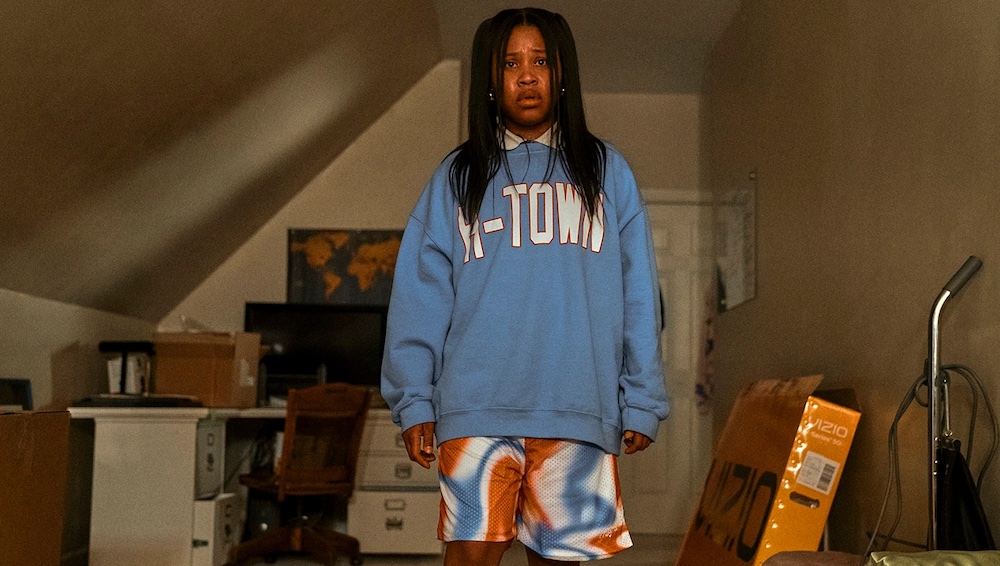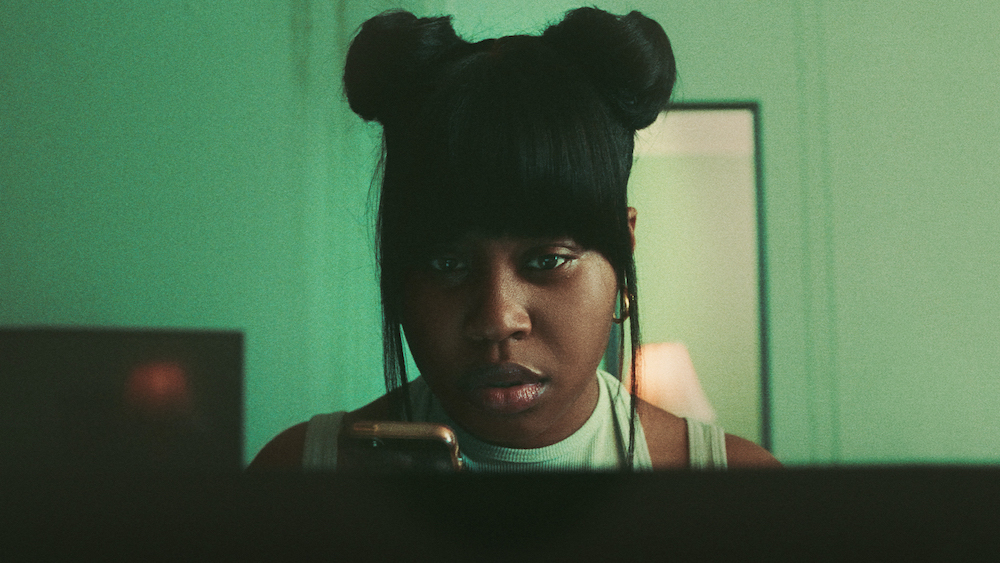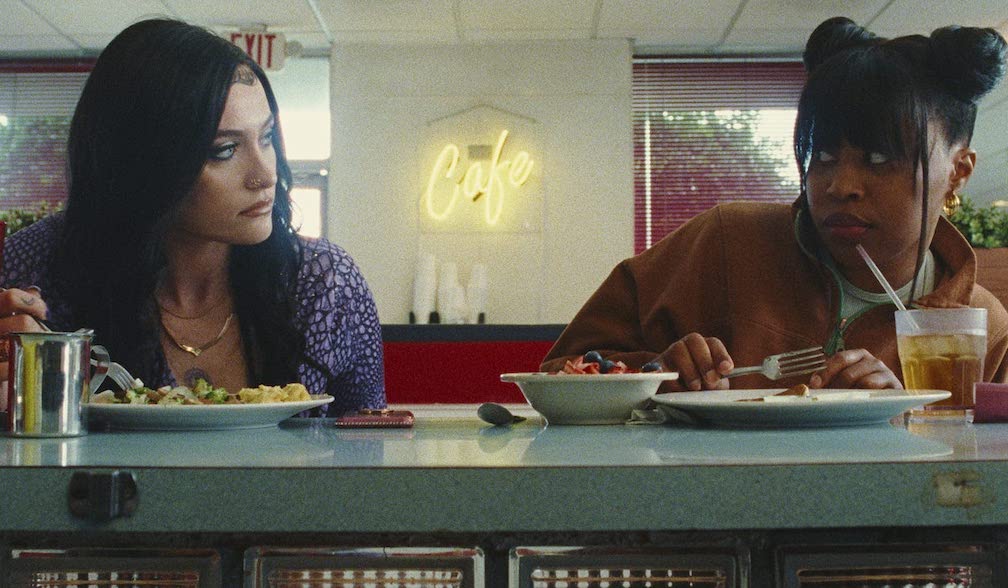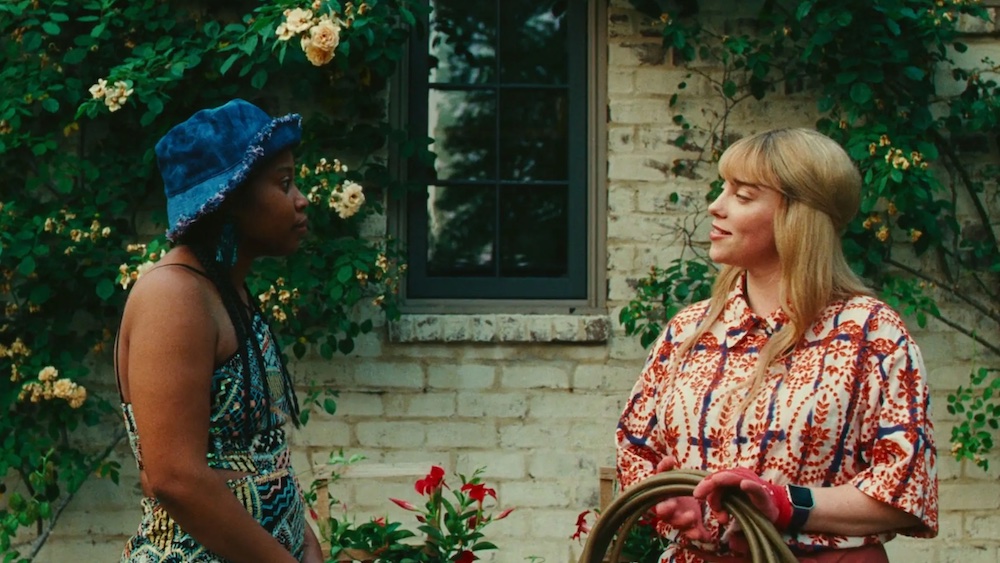
In Swarm, Dre (Dominique Fishback) is the unholy lovechild between Taxi Driver‘s Travis Bickle (Robert De Niro) and Misery‘s Annie Wilks (Kathy Bates). She’s an unwell super fan, living with obsession and trauma as well as a thirst for snacks and violence. In other words, she’s an exceptionally compelling protagonist in Janine Nabers and Donald Glover‘s Amazon Prime series.
The show invites viewers to live in Dre’s world. It is unpleasant, almost always uneasy and suffocating. Production Designer Sara K White, who crafted some damn fine eye candy with The Flight Attendant, makes Dre’s unfortunate place in the awful world all the more tangible. Spaces are tight, colors are harsh, and there’s little warmth or love in sight. Swarm is a fully-realized world, which White recently talked to us about crafting.
[Note: This interview has been edited for clarity and length]
Below-the-Line: What are you working on at the moment?
Sara K White: Well, I am working on keeping myself busy during the writer’s strike. I have a job lined up that is gonna go ideally as soon as this is done. It was supposed to start May 15th, and that was a really rough time. I’m gonna be working with my friend and collaborator, Susanna Fogel (The Flight Attendant), on a new TV series. Once that gets up and running, I’m excited to jump on that project.
BTL: Susanna is great. The Spy Who Dumped Me? Underrated movie.
White: I know [laughs]. I don’t think that it was reviewed in the spirit in which it was made. The comedy is great. I don’t know why people didn’t seem to like it when it came out, but…
BTL: Also, great action. What makes a collaboration between you and a writer, such as herself, work as well as it does?
White: What is great about working with her and the people that she brings onto the project is everyone is always encouraged to bring their A-game, but also, bring ideas that they might not have otherwise. Sometimes there are different ways to structure any film from a director’s point of view. Like, some people have one idea and they just want their team to do it. And then there are other people who create a collaborative environment, and I think it’s up to that director to decide what’s best for them. Working with her, it’s extremely collaborative and everybody is constantly talking about new ideas, talking about different ways to achieve the goal.
It’s really cross-pollinating. It’s not just me talking about what my specific job is. For example, how do we even conceive of the scene in the right location in order to amplify certain themes? Maybe it’s scripted as an office, but it would really be better suited at the home, right? Those discussions are encouraged, and it’s one of the reasons that I really, really love collaborating with Susanna.
BTL: Jumping into Swarm, so much of the show is from Dre’s point-of-view. How’d you want to make the environments as uncomfortable as her perspective?
White: It was entirely about making sure that the audience felt as uncomfortable as possible. Not only because she is a person who is making unconventional choices against the standard social norms, but also because she herself is uncomfortable in the world. She has a hard time existing in the structure of the world. At the very beginning, we see her try to figure it out. Then she finds, you know, what she’s truly passionate about and good at.
It was important to me to keep creating spaces that felt off, where there was some symmetry that wasn’t quite there. So, you as an audience are engaged in looking at what’s around her and being like, “Oh, that’s not exactly what I want it to be. If that picture was over another three inches, then it would make sense to me.” You feel uncomfortable in space. I don’t think that people are watching it, or thinking about the pictures, but it all lends itself to a feeling.

BTL: Maybe the audience won’t actively consider the color choices, for example, but do you choose colors for environments that you think will make people uneasy?
White: You know, we were pretty cash poor on the show, so we had to really do design on a dime, and there weren’t a lot of places where we were able to paint. Something that we did do, though, was in the hotel room in episode two, we made sure to make it an icky green and aged it up quite a bit to make that hotel room feel gross. We were able to bring that color in and make it super gross.
There’s also a lot for both yellow and red. If you watch episode five, when she goes back to her foster parent’s house, there’s a warm beige-yellow tone that’s pervasive throughout the home. The accents of red are really, really hot.
BTL: How’d you initially become obsessed enough with spaces to become a production designer?
White: From a very early age, I was interested in how spaces were arranged. I grew up on Legos, so I was always thinking about how to make spaces. Sometimes I was off the beaten path from what the instructions told me to do. Even with toys when I was super young, I had Barbies and My Little Ponies, and I was much more interested in the spaces I could make for them than the dolls and the ponies themselves [laughs]. I mean, I started rearranging my own childhood bedroom when I was about 10 by drawing floor plans, just imagining the perfect most beautiful bedroom that I could make.
I was just super interested in all of that and I loved furniture, so I ended up going to school for interior design because I liked architecture. I really liked the tactile nature of the furniture and the way that you can get into how people live in an everyday fashion when you’re working with interiors, in a way that you don’t get into the minutiae quite as much. Like, picking out exactly what mug somebody’s gonna pour their coffee into, I think, is a really interesting detail.
BTL: What were the little details crucial to you for Swarm? What did you become obsessed with?
White: I got interested in fandoms. Aside from my obsession with spaces, I don’t really partake in fandoms and all of the minutiae of becoming an ardent fan of pop stars. It’s interesting to me because there are a lot of small pieces that contribute to a shrine in the show. She’s always got a little bit of [the artist] Ni’Jah with her, and it’s not always the focus of a scene, but she’s keeping up on what is on the cover of the People Magazine or the US Weekly and the story about whether or not Ni’Jah’s baby daddy is cheating on her.
Plotting out the obsession and working within the visual landscape of the pop star’s career, that was super exciting. There was a lot of research involved. Also, it was about making those elements and sprinkling them around the world, so there are always hints of celebrity.

BTL: The show is very much like Misery.
White: Yes, absolutely. I love that movie.
BTL: Did you look into these intense members of fandoms online to see specifically how they live?
White: I think that especially right now, one of the best ways to get into somebody’s home environment, who is not wealthy, is a TikTok or a YouTube video. I spend a lot of time watching videos of fans and reading think-pieces written by fans on blogs about their theories about whatever pop star.
Social media is a huge tool, and it’s also an interesting landscape to think about production design in general because, you know, the artifice of social media is strong and well-known at this point, but the tools that individual people use to communicate, it’s the same as the tools that are used in big media, TV, or movies. There’s just an immediacy and intimacy to the ways that those things are employed.
BTL: To circle back a bit, how’d the cinematographer feel about the use of red in the sets? Some cinematographers and filmmakers hate red.
White: We got lucky when we found out that we were gonna be shooting on film. So, that changed our feeling and comfort with red. We knew there was gonna be a lot of blood, that was an early conversation. We didn’t want to hide the viscerally of what was happening. As much as possible we wanted to show her stalking her prey and killing.
We wanted to really understand that she was doing terrible things and was totally okay with the blood splatter on her face and on her hands when she digs into the pie. It’s great because shooting on film, we were able to feel a lot more comfortable with color in general. It gives such a richer tone to all colors. You have a lot more depth. There’s a lot more information to play with when you go back in to do color correcting.
BTL: Is it a bummer knowing that your work might not be shot on film again for a while?
White: Yeah, it’s actually been a long time since I’ve been able to work with film, so it was a great throwback. Over the last 15 years, digital has come around quite a bit. I remember the first things that we shot digitally, people ran from red. It’s certainly not the case anymore.
I think that film brings out the best in everyone because it’s precious. You can roll through 80 takes if you want to when you’re working in a digital medium, but you can’t do that on film. People are more attentive to what’s happening. I think digital can allow people to relax a little bit more than maybe they should [laughs].
BTL: Did you find the grain also added more depth to the locations?
White: Oh, it’s fantastic. Our DP was amazing in amping that up and working with the light in order to create these rich shadows. I’m posting some stuff to social media right now about the behind-the-scenes work that we were doing in the art department. I have to post my own photos, and I can’t post screen grabs, and it’s such a sad comparison, you know? The colors aren’t as rich and the grain isn’t there. Everything’s so sharp and in your face. I gotta color correct some of these ‘cause this is just not what we did [laughs].

BTL: It’s surprising to learn this was your first experience in the horror-thriller genre. What questions did you have going into Swarm and what did you learn?
White: I think that the way that we approached it from a creative team side was to make sure that we were highlighting her actions, the stalking, and the killing. The rest of it was, you know, not terribly different from my side because there was a realism that was focused on in the way that she was otherwise interacting with people.
We definitely talked about framing quite a bit and making sure that we had a lot of options. We allowed Dominique to feel out the scene and find her way through it. So, just giving her the option to move around a set was really important.
From the first conversations that we had with Donald during my first interviews, you know, the movies that he was referencing were less about the horror and more about the deep feelings of discomfort that Dre’s feeling socially. He referenced films like The Piano Teacher, and that is not like a traditional horror film, but certainly disturbing.
BTL: Mandy was an inspiration for you, right?
White: It was just about the color and the visceral nature of the gore. Personally, for me, it was a touchstone for how she’s interacting with the act of killing. I kept that film in the back of my mind as I was working on the project. It wasn’t overly represented, but it was a touchstone as a visual feast.
BTL: The cult house, in particular, is horrifying. The color white is oppressive. It’s such a frightening location.
White: The location was incredible. It was so beautifully selected for the show. It’s a new construction, but it was modeled on European ideas of pastoral elegance, if you will. There were definitely things that had been shipped in for that location that was from old farmhouses in France, but the house had been built within the last decade, so it already had that artifice of pretending to be authentic while clearly not being that.
BTL: What did you want that location to convey?
White: It was about conveying that sort of wellness cult. We tried to amp that up as much as possible. Like, in the dorm room area, we were modeling that on a mental hospital. In the sweat lodge, the ceremony, these things are supposed to be restorative but have been co-opted and bastardized and become a place for people to be taken advantage of in this environment. So, while everything is as beautiful as it can be, there’s definitely an undercurrent of it being disingenuous.
BTL: It’s scary without trying so hard to be scary.
White: Everything was very whispering quiet in the way that it was designed. One other thing that we did, and I actually don’t know how many people noticed, but we put in the stained glass in the EU room and made sure that there are four eyes. The four eyes are around looking at us as we were watching them go through the EU. So, that was an exciting, ominous thing to add.
Swarm is now available to stream on Amazon.





